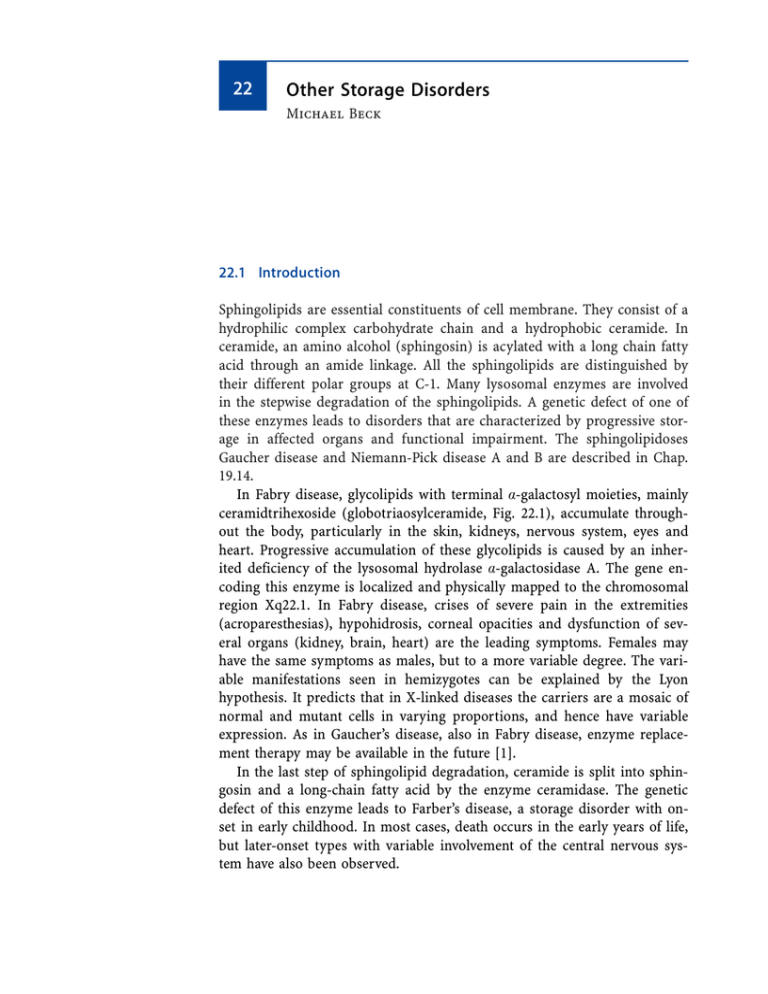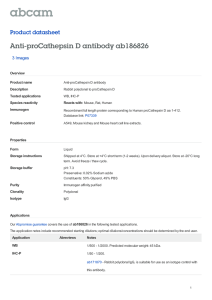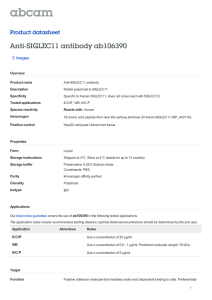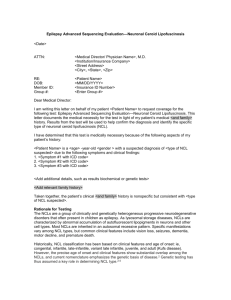Other Storage Disorders 22
advertisement

22 Other Storage Disorders Michael Beck 22.1 Introduction Sphingolipids are essential constituents of cell membrane. They consist of a hydrophilic complex carbohydrate chain and a hydrophobic ceramide. In ceramide, an amino alcohol (sphingosin) is acylated with a long chain fatty acid through an amide linkage. All the sphingolipids are distinguished by their different polar groups at C-1. Many lysosomal enzymes are involved in the stepwise degradation of the sphingolipids. A genetic defect of one of these enzymes leads to disorders that are characterized by progressive storage in affected organs and functional impairment. The sphingolipidoses Gaucher disease and Niemann-Pick disease A and B are described in Chap. 19.14. In Fabry disease, glycolipids with terminal a-galactosyl moieties, mainly ceramidtrihexoside (globotriaosylceramide, Fig. 22.1), accumulate throughout the body, particularly in the skin, kidneys, nervous system, eyes and heart. Progressive accumulation of these glycolipids is caused by an inherited deficiency of the lysosomal hydrolase a-galactosidase A. The gene encoding this enzyme is localized and physically mapped to the chromosomal region Xq22.1. In Fabry disease, crises of severe pain in the extremities (acroparesthesias), hypohidrosis, corneal opacities and dysfunction of several organs (kidney, brain, heart) are the leading symptoms. Females may have the same symptoms as males, but to a more variable degree. The variable manifestations seen in hemizygotes can be explained by the Lyon hypothesis. It predicts that in X-linked diseases the carriers are a mosaic of normal and mutant cells in varying proportions, and hence have variable expression. As in Gaucher’s disease, also in Fabry disease, enzyme replacement therapy may be available in the future [1]. In the last step of sphingolipid degradation, ceramide is split into sphingosin and a long-chain fatty acid by the enzyme ceramidase. The genetic defect of this enzyme leads to Farber’s disease, a storage disorder with onset in early childhood. In most cases, death occurs in the early years of life, but later-onset types with variable involvement of the central nervous system have also been observed. 432 Other Storage Disorders The glycolipid cerebroside-3-sulfate (sulfatide), that represents an essential component of myelin sheaths of the nervous system, is degraded by the enzyme arylsulfatase A. In metachromatic leukodystrophy a deficiency of this enzyme leads to the accumulation of sulfatide in various organs, mainly affecting the central nervous system. The first signs of progressive demyelination are gait disturbances, and later affected patients develop spastic tetraparesis, seizures and dementia. In late onset forms, psychiatric symptoms precede the neurological abnormalities. Deficiency of arylsulfatase A has been observed also in healthy individuals. This so-called “pseudodeficiency” is caused by a mutation in a polyadenylation signal that allows only the synthesis of about 10% of arylsulfatase A compared to the normal allele. In some patients, exhibiting symptoms of the juvenile type of metachromatic leukodystrophy, the disease is caused by a defect in saposin B, an activator that is necessary for full arylsulfatase activity [2]. For treatment, some patients with metachromatic leukodystrophy have had bone marrow transplantations performed. This procedure may slow the progression of the disease [3]. Not only glycosaminoglycans, oligosaccharides and sphingolipids, but also peptides and proteins are degraded in lysosomes. A defect of one of the enzymes that is involved in protein catabolism leads to multiple forms of a neurodegenerative disorder that are known as Batten’s disease (neuronal ceroid lipofuscinosis). All the types of Batten’s disease are characterized by progressive blindness and dementia. Initially, the various forms of Batten’s disease were classified according to age of onset, clinical phenotype and ultrastructural characterization of the storage material. Differences in the ultrastructural appearance of neurons and other cell types (e.g. granular osmiophilic deposits, curvilinear profiles, fingerprint bodies) have been the bases for both diagnosis as well as genetic research. Recently, in some of the several subtypes the underlying metabolic defect has been elucidated enabling the diagnosis to be made by enzymatic (and genomic) analysis [4]. Rapid loss of vision, psychomotor deterioration and seizures are the leading symptoms in infantile neuronal ceroid lipofuscinosis (INCL) where the activity of palmitoyl protein thioesterase 1 is lacking (Fig. 22.2). A deficiency of tripeptidyl peptidase 1 leads to late infantile neuronal ceroid lipofuscinosis (LINCL). In LINCL the storage material consists predominantly of subunit C, a hydrophobic protein that is normally found as an intrinsic inner membrane component of the ATP synthase complex. A defect of a membrane-bound protein (CLN3 protein) has been found in juvenile neuronal ceroid lipofuscinosis. The function of CLN3 protein has not yet been elucidated. Patients with juvenile neuronal ceroid lipofuscinosis show symptoms similar to those of the late infantile type (LINCL), but the progression is slower. In their twenties, affected individuals experience signs of parkinsonism, behavioral problems and psychological abnormalities. Introduction 433 In addition to the types mentioned in this chapter, there are at least five more groups of neuronal ceroid lipofuscinosis where the biochemical abnormality has not been determined although the genes linked to the disorders have been identified [5]. After degradation of glycoproteins, glycosaminoglycans and glycolipids, the acid sugars have to be transported out of the lysosomal compartment. Removal of these small molecules is facilitated by transport systems that have a broad substrate specificity (Fig. 22.3). The mammalian carrier responsible for the transport of N-acetylneuraminic acid (= sialic acid) also recognizes structurally different types of organic anions, like lactate, glucuronic and hexuronic acid. A genetic defect of this anion transporter is responsible for the sialic acid storage disorders [6], that present either as a severe infantile form (ISSD) or as a slowly progressive adult form which is unusually frequent in Finland (Salla disease). As a consequence of the transporter defect, urinary excretion of free sialic acid is increased. In 13 of 21 cases fetal/neonatal ascites or hydrops fetalis was the mode of presentation [7]. The sialic acid storage disorder has to be distinguished from the metabolic disease sialuria, that results from mutations in the gene encoding UDP-N-acetylglucosamine-2-epimerase (UDP-GlcNac-2-epimerase): In the first step of N-acetylneuraminic acid synthesis, UDP-N-acetylglucosamine is converted to N-acetylmannosamine and UDP by the enzyme UDPGlcNac-2-epimerase. This enzyme is inhibited by CMP-N-acetylneuraminic acid, the activated sialic acid donor. Failure of this feedback mechanism due to mutations in the UDP-GlcNac-2-epimerase gene has been determined to be the cause of sialuria [8]. Patients with sialuria, who excrete massive amounts of free sialic acid in their urine (ranging up to several grams a day), show symptoms commonly recognized in storage disorders such as variable degrees of developmental delay, hepatomegaly and mild coarseness of facial features. Skeletal abnormalities (dysostosis multiplex) and seizures have also been observed [9]. 434 Other Storage Disorders 22.2 Nomenclature No. Disorder Enzyme defect Chromosome localization MIM a 22.1 22.2.1 22.2.2 a-Galactosidase A Ceramidase Ceramidase Xq22 8p22-p21.3 8p22-p21.3 301500 228000 228000 Arylsulfatase A 22q13.31-qter 250100 Arylsulfatase A 22q13.31-qter 250100 Saposin B 10q21.1 249900 Palmitoyl protein thioesterase 1 (PPT1) Tripeptidyl peptidase 1 1p32 256730 11p15.5 204500 Membrane protein 16p12.1 204200 604322 (#269920)* 6q14-q15 604369 (#269920)* 22.6 Sialuria Sialin (specific transporter) Sialin (specific transporter) UDP-N-acetylglucosamine 2-epimerase 6q14-q15 22.5.2 Fabry disease Farber disease (classical type) Farber disease (intermediate and mild type) Metachromatic leukodystrophy, infantile form Metachromatic leukodystrophy, juvenile form Metachromatic leukodystrophy (SAP B defect) Infantile neuronal ceroid lipofuscinosis (CLN1) Late infantile neuronal ceroid lipofuscinosis (CLN2) Juvenile neuronal ceroid lipofuscinosis (CLN3) Sialic acid storage disorder (infantile form) Sialic acid storage disorder (Salla disease) 9p12-p11 269921 22.3.1 22.3.2 22.3.3 22.4.1 22.4.2 22.4.3 22.5.1 a A number sign (#) is used with this entry because of both the infantile (MIM 604322) and Finnish (Salla disease, MIM 604369) forms of sialuria are due to mutation in the SLC17A5 gene (MIM 604322). 22.3 Metabolic Pathways Fatty acid Galactose Galactose Glucose Ceramidase 22.2.1 and 22.2.2 Sphingosin α -Galactosidase A 22.1 Fatty acid Galactose S Arylsulfatase A 22.3.1 and 22.3.2 Ceramidase 22.2.1 and 22.2.2 Sphingosin Fig. 22.1. Degradation of sphingolipids. The numbers in bold indicate the diseases listed in Sect. 22.2 Metabolic Pathways Sub C Fig. 22.2. Lysosomal catabolism of membrane-associated/ hydrophobic proteins. In infantile neuronal ceroid lipofuscinosis (CLN1) palmitoyl protein thioesterase is deficient (22.4.1). Late infantile neuronal lipofuscinosis (CLN2) is due to a defect in tripeptidyl peptidase I (22.4.2). Sub C = subunit C of ATP synthase complex. CLN3 protein = membrane protein of unknown function. It probably contributes to the disposal of organella membranes, it is defective in juvenile neuronal ceroid lipofuscinosis (CLN3, 22.4.3) CLN3 protein 435 Lyso mem somal bran e CLN3 22.4.3 CLN1 22.4.1 CLN2 22.4.2 Amino acids = fatty acid, = protein, = peptide Glucosamine UDP-N-acetylglucosamine UDP-N-acetylglucosamine 2-epimerase: 22.6 N-acetylmannosamine (-) N-acetylneuraminic acid (sialic acid) Specific transporter 22.5.1 and 22.5.2 N-acetylneuraminic acid (sialic acid) CMP-N-acetylneuraminic acid Lysosom Fig. 22.3. Metabolism of free N-acetylneuraminic acid (= sialic acid): UDP-acetylglucosamine 2-epimerase is inhibited by the activated sialic acid donor, CMP-N-acetylneuraminic acid, which also provides N-acetylneuraminic acid for glycoconjugate synthesis. In sialuria (22.6) loss of feedback inhibition leads to overproduction of sialic acid. In sialic acid storage disorders (22.5.1 and 22.5.2) N-acetylneuraminic acid accumulates in the lysosomes due to a defect of a specific transporter (sialin) 436 Other Storage Disorders 22.4 Signs and Symptoms System Signs/symptoms Clinical course Age at onset Age at death Characteristic clinical findings Facies Skeleton Eye Ear Central nervous system Cardiac Kidney Spleen Liver GI Dermatologic Special laboratory Coarse facial features Joint swelling Joint thickening Joint deformity Contractures Corneal opacities Cornea verticillata Cataract Macular cherry red spot Tinnitus Stroke Mental retardation Neurological deterioration Dementia Valvular thickening Cardiomegaly Renal insufficiency Splenomegaly Hepatomegaly Swallowing difficulties Diarrhea Angiokeratoma Hypohidrosis Lipid crystals in urine sediment (Maltese cross) Disorders 22.1 Fabry disease 22.2.1 Farber disease, classical type 22.2.2 Farber disease, intermediate and mild type <10 >40 Angiokeratoma Cornea verticillata Acroparesthesia ± + <4 months <1 year Joint swelling Hoarseness <20 months <20 years Joint swelling Hoarseness +++ +++ +++ +++ ± +++ +++ +++ +++ ± ± +++ +++ ± ± +++ ± ± ± ± + ++ +++ + +++ +++ +++ + + + + + ± ± ± ± ± ± ± ++ ± ± ± Signs and Symptoms System Signs/symptoms Clinical course Age at onset Age at death Characteristic clinical findings Skeleton Eye Genu recurvatum Optic atrophy Greyish colour of macula Nystagmus Peripheral ner- Neuropathy vous system Central nerBehaviour abnormality vous system Ataxia Spastic tetraplegia Seizures Progressive mental retardation Kidney Renal tubular acidosis Spleen Splenomegaly Liver Hepatomegaly GI Gallbladder papilloma Gallbladder stones Gastrointestinal hemorrhage Swallowing difficulties Special Increased sulfatide excretion laboratory Increased spinal fluid protein Nerve conduction velocity reduced 437 Disorders 22.3.1 Metachromatic leukodystrophy, infantile 22.3.2 Metachromatic leukodystrophy, juvenile 22.3.3 Metachromatic leukodystrophy (SAP B deficiency) <2 years <10 years Spastic tetraplegia Optic atrophy Gallbladder stones ± ++ ++ ++ +++ <10 years <20 year Spastic tetraplegia Optic atrophy Gallbladder stones <2 years <20 years Spastic tetraplegia Optic atrophy + ± ± ++ ++ ± +++ +++ ± +++ ++ + +++ ++ +++ ++ ± +++ +++ +++ ± ± ± ± + ± +++ +++ +++ +++ ± + ++ +++ +++ +++ ++ +++ + +++ 438 Other Storage Disorders System Signs/symptoms Clinical course Age at onset Age at death Characteristic clinical findings Skeleton Eye Central nervous system Cardiac Dermatologic EM findings (nerve cells) Microcephaly Optic atrophy Retina degeneration Cataract Brownish colour of macula ERG abnormality Muscular hypotonia Ataxia Myoclonus Seizures Progressive mental retardation ECG abnormality Hirsutism Hyperpigmentation Granular osmiophilic deposits Curvilinear profiles Rectilinear profiles Disorders 22.4.1 Neuronal ceroid-lipofuscinosis, infantile 22.4.2 Neuronal ceroid-lipofuscinosis, late infantile 22.4.3 Neuronal ceroid-lipofuscinosis, juvenile <1 year <10 years Visual failure Seizures Mental retardation + +++ +++ <4 years <10 years Visual failure Seizures Mental retardation + + + <7 years <30 years Visual failure Psychotic symptoms Parkinsonism +++ +++ +++ ++ ++ +++ +++ +++ ± ++ ++ +++ +++ +++ ± ± ± + ++ +++ +++ + +++ + + +++ +++ +++ Signs and Symptoms System Signs/symptoms Clinical course Age at onset Age at death Characteristic clinical findings Facies Skeleton Coarse facial features Dysostosis multiplex Thickened calvarium Eye Pale fundus Nystagmus Central nerSpastic tetraplegia vous system Seizures Cardiac Cardiomegaly Kidney Nephrotic syndrome Spleen Splenomegaly Liver Hepatomegaly GI Ascites Unique clinical Hydrops fetalis findings Laboratory Urine excretion of free N-acetylneuraminic acid Disorders 22.5.1 Sialic acid storage disease, infantile form 22.5.2 Sialic acid storage disease, adult form, Salla disease 22.6 Sialuria from birth <4 years Coarse facial features >6 months <2 years normal life expectancy Ataxia Mental retardation Mental retardation Fair skin +++ +++ Dysarthria Mental retardation + Cardiomegaly Hepatosplenomegaly + + + + ± +++ ++ ++ +++ +++ ± ± +++ + ++ + + + +++ +++ +++ + +++ 439 440 Other Storage Disorders 22.5 Laboratory Diagnosis Disorder Enzyme defect Material Method Postnatal diagnosis Prenatal diagnosis 22.1 a-Galactosidase A 22.2.1 and 22.2.2 Ceramidase 22.3.1 and 22.3.2 Arylsulfatase A 22.3.3 Saposin B 22.4.1 Palmitoyl protein thioesterase 1 (PPT1) 22.4.2 Tripeptidyl peptidase I WBC, P, FB FB WBC, FB FB WBC, FB CV, AFC AFC CV, AFC AFC CV, AFC WBC, LYM AFC 22.4.3 WBC, LYM AFC 22.5.1 and 22.5.2 Sialin (specific transporter) U, FB AFC 22.6 U, FB AFC a Membrane protein UDP-N-acetylglucosamine 2-epimerase Enzyme assay a Enzyme assay a Enzyme assay a Enzyme assay b Enzyme assay b, ultrastructural investigation c Mutation analysis, ultrastructural investigation c Mutation analysis, ultrastructural investigation c Measurement of free sialic acid in urine and fibroblasts Measurement of free sialic acid in urine and fibroblasts, enzyme assay b The diagnosis of these groups of disorders relies upon the demonstration of a profound deficiency of specific enzymatic activities, assayed in the appropriate material. Since assay conditions are very variable in different laboratories, reference values are not given here. b These enzyme defects can be detected in only a few laboratories specialized in these rare disorders. c In neuronal ceroid lipofuscinosis the diagnosis may be based on the demonstration of a characteristic ultrastructural pattern in lymphocytes and/or nerve cells alone. The diagnosis can be confirmed by mutation analysis. Diagnostic Flow Charts 441 22.6 Diagnostic Flow Charts Fig. 22.4. Clinical approach to the diagnosis of Fabry disease. In affected females, a-galactosidase activity is often in the normal range. In those cases, the diagnosis has to be confirmed by mutation analysis. CTH = Ceramidtrihexoside Acroparesthesia Angiokeratoma Excretion of CTH N Y α -Galactosidase A deficiency Erythromelalgia N (female patients) Y Mutation analysis Y Fabry disease Fabry disease Fig. 22.5. Joint swelling and hoarseness are the leading symptoms in Farber’s disease Joint swelling Inflammation signs Hoarseness Suspicion of Farber's disease Rheumatoid arthritis Reduced ceramidase activity Farber's disease Fig. 22.6. As there are healthy individuals with deficient arylsulfatase A activity, the diagnosis of metachromatic leukodystrophy cannot be made by enzyme analysis alone. The diagnosis must be confirmed by the detection of increased protein concentration in spinal fluid and reduced nerve conduction velocity. Increased sulfatide excretion is also found in Saposin B deficiency Spastic tetraplegia Progressive mental retardation Y Y Increased spinal fluid protein Nerve conduction velocity reduced Increased sulfatide excretion Y Arylsulfatase activity reduced Y Metachromatic leukodystrophy N Saposin B deficiency 442 Other Storage Disorders Visual failure Progressive mental retardation Y Y Ultrastructural investigation (lymphocytes, skin, ectal biopsy Y Y Y Granular osmiophilic deposits Curvilinear profiles Y Rectilinear profiles Y Mutation analysis (CLN1) Y Mutation analysis (CLN2) Y Mutation analysis (CLN3) Y Infantile type (CLN1) Y Late infantile type (CLN2) Juvenile type (CLN3) Fig. 22.7. In the several types of neuronal ceroid lipofuscinosis, the diagnosis is based on characteristic clinical features (visual loss and progressive mental retardation) and on the demonstration of ultrastructural changes in several cell types (nerve cells, lymphocytes). Mutation analysis enables the definitive diagnosis Coarse facial features Progressive mental retardation Urinary sialic acid Y Sialic acid increased in fibroblasts Y UDP-N-Acetylglucosamine 2 – epimerase mutation N Sialic storage disorder Y Sialuria Fig. 22.8. Coarse facial features and progressive mental retardation are characteristic symptoms in both, sialic storage disorder and sialuria. Differentiation is possible only by measuring UDP-acetylglucosamine 2-epimerase, that is mutated in sialuria References 443 22.7 Summary Angiokeratoma, hypohidrosis and renal dysfunction are the primary symptoms of Fabry disease (a-galactosidase deficiency), an X-linked storage disorder with clinical manifestation also in the female carriers. Farber’s disease (ceramidase deficiency) is characterized by painful joint swelling and hoarseness. In many patients mental retardation is also observed. In metachromatic leukodystrophy (arylsulfatase A or saposin B deficiency) progressive demyelination leads to severe neurodegenerative symptoms. In patients with progressive mental retardation combined with visual loss, one of the several types of Batten’s disease (neuronal ceroid lipofuscinosis) has to be considered. That diagnosis is based on the detection of ultrastructural alterations in nerve cells and lymphocytes. In the sialic acid storage disorders (infantile and adult form) sialic acid is stored in the lysosomes because of a defect of a specific transporter. In sialuria there is an increase of sialic acid synthesis caused by a failure of a feedback mechanism. The sialic storage disorders and sialuria have in common clinical symptoms such as developmental delay and visceromegaly. References 1. Schiffmann R, Murray GJ, Treco D, Daniel P, Sellos-Moura M, Myers M, Quirk JM, Zirzow GC, Borowski M, Loveday K, Anderson T, Gillespie F, Oliver KL, Jeffries NO, Doo E, Liang TJ, Kreps C, Gunter K, Frei K, Crutchfield K, Selden RF, Brady RO. Infusion of alpha-galactosidase A reduces tissue globotriaosylceramide storage in patients with Fabry disease. Proc Natl Acad Sci USA 2000; 97(1):365 2. Regis S, Filocamo M, Corsolini F, Caroli F, Keulemans JL, van Diggelen OP, Gatti R. An Asn ? Lys substitution in saposin B involving a conserved amino acidic residue and leading to the loss of the single N-glycosylation site in a patient with metachromatic leukodystrophy and normal arylsulphatase A activity. Eur J Hum Genet 1999; 7(2):125 3. Kapaun P, Dittmann RW, Granitzny B, Eickhoff W, Wulbrand H, Neumaier-Probst E, Zander A, Kohlschuetter A. Slow progression of juvenile metachromatic leukodystrophy 6 years after bone marrow transplantation. J Child Neurol 1999; 14(4):222 4. Dawson G, Cho S. Batten’s disease: clues to neuronal protein catabolism in lysosomes. J Neurosci Res 2000; 60(2):133 5. Peltonen L, Savukoski M, Vesa J. Genetics of the neuronal ceroid lipofuscinoses. Curr Opin Genet Dev 2000; 10(3):299 6. Verheijen FW, Verbeek E, Aula N, Beerens CE, Havelaar AC, Joosse M, Peltonen L, Aula P, Galjaard H, van der Spek PJ, Mancini GM. A new gene, encoding an anion transporter, is mutated in sialic acid storage diseases. Nat Genet 1999; 23(4):462 7. Lemyre E, Russo P, Melancon SB, Gagne R, Potier M, Lambert M. Clinical spectrum of infantile free sialic acid storage disease. Am J Med Genet 1999; 82(5):385 8. Seppala R, Lehto VP, Gahl WA. Mutations in the human UDP-N-acetylglucosamine 2-epimerase gene define the disease sialuria and the allosteric site of the enzyme. Am J Hum Genet 1999; 64(6):1563. 9. Ferreira H, Seppala R, Pinto R, Huizing M, Martins E, Braga AC, Gomes L, Krasnewich DM, Sa Miranda MC, Gahl WA. Sialuria in a Portuguese girl: clinical, biochemical, and molecular characteristics. Mol Genet Metab 1999; 67(2):131






